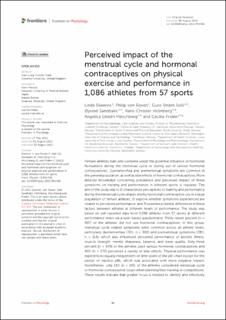Perceived impact of the menstrual cycle and hormonal contraceptives on physical exercise and performance in 1,086 athletes from 57 sports
Ekenros, Linda; von Rosen, Philip; Solli, Guro Strøm; Sandbakk, Øyvind; Holmberg, Hans-Christer; Hirschberg, Angelica Lindén; Fridén, Cecilia
Peer reviewed, Journal article
Published version
Permanent lenke
https://hdl.handle.net/11250/3040061Utgivelsesdato
2022Metadata
Vis full innførselSamlinger
Originalversjon
Ekenros, L., von Rosen, P., Solli, G. S., Sandbakk, Ø., Holmberg, H., Hirschberg, A. L. & Fridén, C. (2022). Perceived impact of the menstrual cycle and hormonal contraceptives on physical exercise and performance in 1,086 athletes from 57 sports. Frontiers in Physiology, 13:954760. doi: 10.3389/fphys.2022.954760Sammendrag
Female athletes train and compete under the potential influence of hormonal fluctuations during the menstrual cycle or during use of various hormonal contraceptives. Dysmenorrhea and premenstrual symptoms are common in the general population, as well as side effects of hormonal contraceptives. More detailed knowledge concerning prevalence and perceived impact of these symptoms on training and performance in different sports is required. The aim of the study was to 1) characterize perceptions of training and performance during the menstrual cycle phases and by hormonal contraceptive use in a large population of female athletes; 2) explore whether symptoms experienced are related to perceived performance; and 3) examine potential differences in these factors between athletes at different levels of performance. The study was based on self-reported data from 1,086 athletes from 57 sports at different performance levels via a web-based questionnaire. Thirty-seven percent (n = 407) of the athletes did not use hormonal contraceptives. In this group, menstrual cycle related symptoms were common across all athlete levels, particularly dysmenorrhea (74%, n = 300) and premenstrual symptoms (78%, n = 318), which also influenced perceived performance of aerobic fitness, muscle strength, mental sharpness, balance, and sleep quality. Sixty-three percent (n = 679) of the athletes used various hormonal contraceptives and 40% (n = 272) perceived a variety of side-effects. Physical performance was experienced equally independent of time-point of the pill-chart except for the period of inactive pills, which was associated with more negative impact. Nonetheless, only 18% (n = 191) of the athletes considered menstrual cycle or hormonal contraceptive issues when planning their training or competitions. These results indicate that greater focus is needed to identify and effectively treat different menstrual cycle and hormonal contraceptive related symptoms on an individual level.

